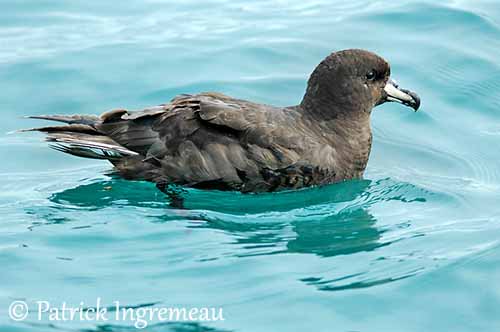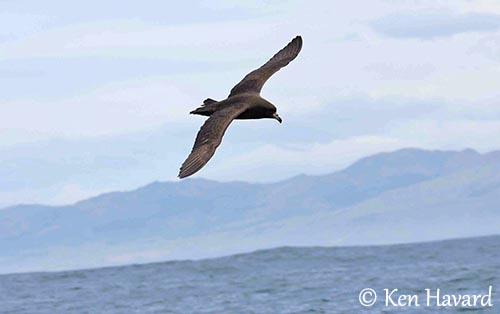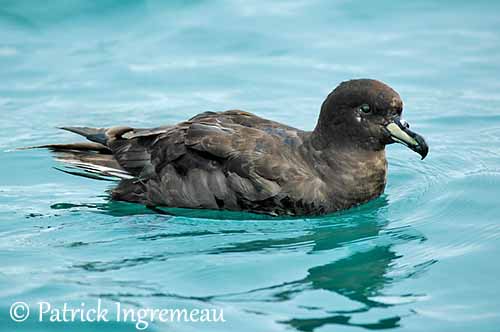Fr: Pétrel du Westland - Puffin du Westland
Maori: Tāiko
Ang: Westland Petrel
All: Westlandsturmvogel
Esp: Pardela de Westland
Ita: Procellaria di Westland
Nd: Westlandstormvogel
Sd: Större sotpetrell
Photographers:
Ken Havard
His Bird Pictures on IBC et Flickr gallery
Patrick Ingremeau
TAMANDUA
Text by Nicole Bouglouan
Sources:
HANDBOOK OF THE BIRDS OF THE WORLD vol 1 by Josep del Hoyo-Andrew Elliot-Jordi Sargatal - Lynx Edicions - ISBN: 8487334105
BirdLife International (BirdLife International)
New Zealand birds and birding (Narena Olliver)
New Zealand bird status between 2008 and 2012
Te Ara – The Encyclopedia of New Zealand
Page family Procellariidae
Summary cards
Westland Petrel
Procellaria westlandica
Procellariiformes Order – Procellariidae Family
INTRODUCTION:
The Westland Petrel is one of the few petrels still breeding on New Zealand mainland. Although being the largest burrowing petrel, this species is vulnerable to introduced dogs and cats, and also stoats and rats, whereas pigs destroy the nesting burrows.
The Westland Petrel suffered heavy degradation of the habitat due to human activities. However, it inhabits much of the same breeding range as it did formerly, prior to human habitations. This species is endemic to New Zealand.
DESCRIPTION OF THE BIRD:
Biometrics:
Length: 50-55 cm
Wingspan: 135-140 cm
Weight: 800-1200 g
The adult has sooty-black plumage overall, including head and neck which are often darker. However, a few birds may have some odd white feathers.
On the underwing, the bases of primaries and coverts are greyer and slightly paler.
The bill is ivory to pale yellowish, with blackish culmen and tips of both mandibles. The eyes are dark brown. Legs and webbed feet are blackish.
Male and female have similar appearance.
The juvenile resembles adult but it has whiter bill.
RANGE:
The Westland Petrel occurs on the West Coast of the South island. They breed in coastal forests in the foothills of the Paparoa Range, near Punakaiki on South Island.
During winter, it is the most common petrel found in Cook Strait and northern South Island.
HABITAT:
The Westland Petrel breeds in densely forested hills and coastal forests on the mainland, and forages off the Kaikoura and Westland coasts.
Outside the breeding season, it is found over the ocean.

CALLS AND SONGS: SOUNDS BY XENO-CANTO
The Westland Petrel is mostly silent at sea, but it is more vocal at colonies. It produces a variety of sounds such as quacking, humming and braying with a fairly nasal voice.
Usually, calling is more intense at the beginning of the breeding season, and mainly between dusk and dawn.
BEHAVIOUR IN THE WILD:
The Westland Petrel feeds mainly on fish, cephalopods and crustaceans, and also fisheries waste.
It is usually solitary when feeding at sea, but it often joins mixed-species flocks around fishing vessels for fisheries waste. This type of food is a substantial part of the diet of these birds.
The Westland Petrel feeds mainly during the day while sitting on water. But during the breeding season, it also feeds at night to avoid predation. It takes the prey with the bill, and may dive and swim under water. It uses its wings to propel itself at several metres of depth.

This species is colonial breeder and nests in burrows or other cavities. As these birds spend most of their time at sea, they return to the colonies at night where they are more vulnerable. But the large numbers are a good protection against predators.
When a bird returns to its breeding grounds, it joins in the noisy struggle in order to find a burrow and a mate. The newly formed pairs may spend long periods of time at their nest, and sometimes for more than one season before starting to breed. They are monogamous with long-term pair-bonds.
The courtship displays usually occur inside the burrow and consist largely of “billing” with oil dribbling down the bill. Both mates also perform mutual preening. Then, they give series of long calls.
The Westland Petrel is active by night on the breeding grounds, and it flies in or out of the breeding site within the first hours after sunset and until the last hour before sunrise. This nocturnal behaviour allows the bird to avoid avian predators such as New Zealand Falcon and Swamp Harrier. It searches for food during the night to feed the chicks in the burrow.
It migrates after breeding to western South America. They may round Cape Horn to occur off Argentina. The juveniles can be seen off southern Peru, S to Central Chile before they start to breed, but the adults fly towards S Chile and Cape Horn area for moulting.
The Westland Petrel is a good flier like all the Procellariidae species. It flies with active wingbeats interspersed with glides on stiff wings. It may soar in thermal currents too.
In order to take-off from land, it climbs onto tree stumps or cliff tops, and takes flight from high site because it is not able to lift itself directly off the ground.

REPRODUCTION OF THIS SPECIES:
The breeding season starts in March-April with the laying in May-June.
The Westland Petrel nests in a burrow of 1-2 metres long, excavated by the birds with bill and feet, but it may also use cavities, hollow logs or a cavity among tree roots. The nest is usually made close to take-off points. There is some lining in the nest chamber such as leaves, twigs, feathers and debris.
This species breeds in colonies established along an 8 kilometres area of coastal forest in the West Coast of the South Island.
The female lays a single, large, white egg at the end of the burrow. The incubation shared by both adults lasts 57-68 days. The chick is brooded for 1-2 weeks, and fed by regurgitation by parents. It fledges 120-140 days after hatching. It may still have grey downy plumage, or a mixture of some down and adult plumage. It explores the surroundings of the nest and learns the flight technique by exercising its wings and practising launchings. Then, it heads out to the sea. It will return to the colony 5 years later, and will start to breed at 10 years old.
PROTECTION / THREATS / STATUS:
The Westland Petrel has currently fairly stable population of about 10,700 mature individuals. The species is threatened by introduced predators, but also by the native Weka which takes eggs and chicks and may kill adults.
Human activities such as mining and agriculture have destroyed areas of suitable habitat. As partially nocturnal species, the birds are attracted by lights and are killed by flying into power pylons. They are vulnerable to fishing nets while following trawlers. In addition, they have restricted breeding range in New Zealand.
The Westland Petrel is currently listed as Vulnerable. In New Zealand, it is considered Naturally Uncommon by the NZ threat classification.
